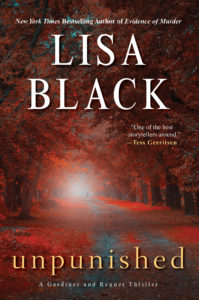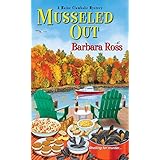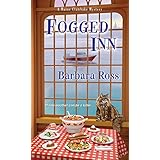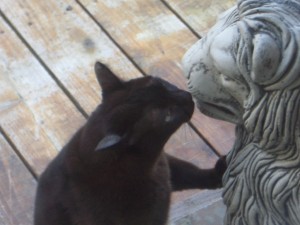Time to welcome back my guest, Lisa Black, forensic scientist by day and thriller writer by night. Not surprisingly, Lisa’s become fascinated with the case of the Black Dahlia, and she uses it to tell us about the differences between real-life investigation and creating a fictional case, below. Here’s the scoop on her newest book, Unpunished, published by Kensington Books this week!
 It begins with the kind of bizarre death that makes headlines—literally. A copy editor at the Cleveland Herald is found hanging above the grinding wheels of the newspaper assembly line. Forensic investigator Maggie Gardiner has her suspicions about this apparent suicide inside the tsunami of tensions that is the news industry today—and when the evidence suggests murder, Maggie has no choice but to place her trust in the one person she doesn’t trust at all….
It begins with the kind of bizarre death that makes headlines—literally. A copy editor at the Cleveland Herald is found hanging above the grinding wheels of the newspaper assembly line. Forensic investigator Maggie Gardiner has her suspicions about this apparent suicide inside the tsunami of tensions that is the news industry today—and when the evidence suggests murder, Maggie has no choice but to place her trust in the one person she doesn’t trust at all….
Jack Renner is a killer with a conscience, a vigilante with his own code of honor. He has only one problem: Maggie knows his secret. She insists he enforce the law, not subvert it. But when more newspaper employees are slain, Jack may be the only person who can help Maggie unmask the killer–even if Jack is still checking names off his own private list.
TRUTH MAY BE STRANGER THAN FICTION…BUT FICTION IS MUCH MORE COOPERATIVE
By Lisa Black
Writing murder mysteries means I can make up everything I need to happen. Sometimes that involves juggling some logistics—actually it always means juggling some logistics—but if some plot twist is really giving me a problem, I can simply rewrite it. True crime, however, stubbornly refuses to dot every i or even consider crossing every t. Take the case of the Black Dahlia, which I have been researching for a presentation at the Sleuthfest mystery writer’s convention.
First there was the nightclub owner who ran a sort of free boarding house for young starlets. He employed them in his burlesque show where they hoped to be spotted by those elusive Hollywood agents. No red flags there, right? But according to him he had a house full of these girls, overseen by his long-time girlfriend, and the address book with his embossed name on the cover found in Beth’s luggage had been ‘liberated’ from his desk without his knowledge. Certainly none of these budding starlets ever complained of harsh treatment at his hands. But this was 1947. Women didn’t complain about much—it didn’t help, and only got them more of the same.
Then there was the control freak/charming-when-he-wants-to-be Dr. George Hodel. Though married (always temporarily; he tended to abandon wives like used razor blades) he had a habit of picking up young beauties to photograph them. As a surgeon he certainly had the means to rent a room for the killing and a car to transport the body, and for motive you need look no further than his fascination with the Marquis de Sade. Unfortunately we don’t even have an embossed address book in the way of hard proof that Hodel ever met Beth Short.
Then there’s the tall, skinny guy with a limp. Not kidding. A tall guy with a limp turns up in a number of places in Beth’s timeline and also in the narrative surrounding some other L.A. murders. But in the days before cell phone cameras made selfies ubiquitous, ‘tall, thin and with a limp’ was the most detailed description available to detectives. But this was only a year or two out from WWII, so there were probably quite a number of veterans with leg injuries. And with average daily caloric intake at near-record lows around this time, it wouldn’t be surprising if most people had figures we would envy in today’s TV-watching, corn-syrup-sweetened world. So that doesn’t really narrow it down.
Of course there’s always the mob. As in any large city they had a presence, and with a girl like Beth looking for a way into the studios it doesn’t take a lot of imagination to see her cozying up to a made man at a nightclub. Unfortunately, imagination is most of what we have. Like any well-brought up girl, Beth didn’t kiss and tell. She often made reference to ex-boyfriends, even jealous ex-boyfriends, but never named names.
Then there’s Arnold Smith, aka, Jack Anderson Wilson, who supposedly sent an informant to the cops to relay his tale. This informant, unnamed in the books, said that Arnold Smith said that a guy he knew named Al Morrison told Smith, in great detail, how he had killed Beth Short. Smith, incidentally, was described by the informant as tall, thin, and walking with a limp, and detectives figured this Al Morrison never existed and served the “I’m not asking for me, but for a friend of mine” purpose. Most significantly, he knows details of Beth’s anatomy that the police never leaked. Unfortunately the cops never got to speak to Wilson directly. He would only meet the informant by chance at a bar and though the informant, with cops around him, kept waiting, Smith didn’t show. Instead he continued a bad habit of smoking in bed and set his hotel room on fire, taking his secrets into the next life.
And since the crime occurred 60 years ago, witnesses cannot be re-questioned for more details, no phone records or hotel registries have survived, and the autopsy report was never made public so we can’t even be sure what is myth and what is fact in the swirl of cyberspace language regarding the life and death of Beth Short.
No wonder I write fiction.
PS If you want to know more about the Black Dahlia murder and the evidence that exists implicating these and other suspects, come to MWA’s Sleuthfest in Boca Raton this February!
 About Lisa: Lisa Black has spent over 20 years in forensic science, first at the coroner’s office in Cleveland Ohio and now as a certified latent print examiner and CSI at a Florida police dept. Her books have been translated into 6 languages, one reached the NYT Bestseller’s List and one has been optioned for film and a possible TV series. Find out more on her website, www.lisa-black.com , and chat with her on Twitter, @LisaBlackAuthor.
About Lisa: Lisa Black has spent over 20 years in forensic science, first at the coroner’s office in Cleveland Ohio and now as a certified latent print examiner and CSI at a Florida police dept. Her books have been translated into 6 languages, one reached the NYT Bestseller’s List and one has been optioned for film and a possible TV series. Find out more on her website, www.lisa-black.com , and chat with her on Twitter, @LisaBlackAuthor.
 [I tell beginning writers to be] “stubborn. Be tenacious. Commit yourself to the inevitability of failure. Sentences are going to fail, chapters … whole books … [P]ay close attention to [your] own life. Don’t avoid your own passions and fears. There’s a tendency, I think, to sublimate it all, or to become so oblique as to avoid entirely that which has hurt you or that which has jerked you awake at night. I know of no rule that commands a writer to be subtle at all costs. At times, I believe, it doesn’t hurt to be blunt.”
[I tell beginning writers to be] “stubborn. Be tenacious. Commit yourself to the inevitability of failure. Sentences are going to fail, chapters … whole books … [P]ay close attention to [your] own life. Don’t avoid your own passions and fears. There’s a tendency, I think, to sublimate it all, or to become so oblique as to avoid entirely that which has hurt you or that which has jerked you awake at night. I know of no rule that commands a writer to be subtle at all costs. At times, I believe, it doesn’t hurt to be blunt.”
 Musselled Out (2015) and Fogged Inn (2016) by
Musselled Out (2015) and Fogged Inn (2016) by  Obviously, she stayed, or there would be no fourth book! In Fogged Inn, Julia investigates a death that appears to be closely linked to four couples determined to deny any connection with the dead man—or each other. Fogged Inn explores old friendships and new tensions. The author set herself two challenges—one obvious on the first page, the other on the last—and meets them both beautifully. This book is nominated for an Agatha Award for Best Contemporary Novel, and deservedly. I’m in awe. (Next up: Iced Under, published in December 2016.)
Obviously, she stayed, or there would be no fourth book! In Fogged Inn, Julia investigates a death that appears to be closely linked to four couples determined to deny any connection with the dead man—or each other. Fogged Inn explores old friendships and new tensions. The author set herself two challenges—one obvious on the first page, the other on the last—and meets them both beautifully. This book is nominated for an Agatha Award for Best Contemporary Novel, and deservedly. I’m in awe. (Next up: Iced Under, published in December 2016.)


 It begins with the kind of bizarre death that makes headlines—literally. A copy editor at the Cleveland Herald is found hanging above the grinding wheels of the newspaper assembly line. Forensic investigator Maggie Gardiner has her suspicions about this apparent suicide inside the tsunami of tensions that is the news industry today—and when the evidence suggests murder, Maggie has no choice but to place her trust in the one person she doesn’t trust at all….
It begins with the kind of bizarre death that makes headlines—literally. A copy editor at the Cleveland Herald is found hanging above the grinding wheels of the newspaper assembly line. Forensic investigator Maggie Gardiner has her suspicions about this apparent suicide inside the tsunami of tensions that is the news industry today—and when the evidence suggests murder, Maggie has no choice but to place her trust in the one person she doesn’t trust at all…. About Lisa: Lisa Black has spent over 20 years in forensic science, first at the coroner’s office in Cleveland Ohio and now as a certified latent print examiner and CSI at a Florida police dept. Her books have been translated into 6 languages, one reached the NYT Bestseller’s List and one has been optioned for film and a possible TV series. Find out more on her website,
About Lisa: Lisa Black has spent over 20 years in forensic science, first at the coroner’s office in Cleveland Ohio and now as a certified latent print examiner and CSI at a Florida police dept. Her books have been translated into 6 languages, one reached the NYT Bestseller’s List and one has been optioned for film and a possible TV series. Find out more on her website,